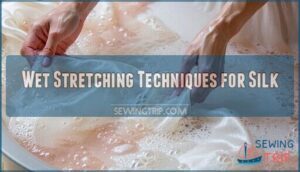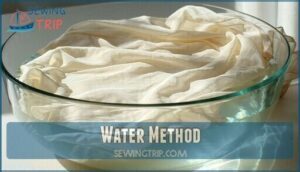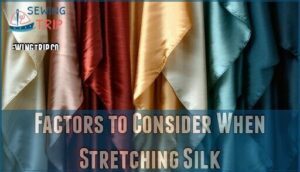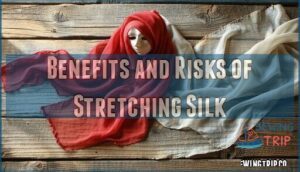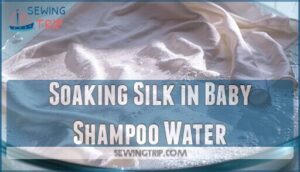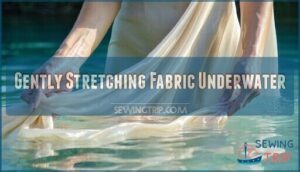This site is supported by our readers. We may earn a commission, at no cost to you, if you purchase through links.

Silk fibers have natural elasticity that allows for gentle stretching when wet, typically up to 20% of the original size.
The trick lies in using lukewarm water and baby shampoo to soften the fibers, then carefully manipulating the fabric while it’s damp.
However, success depends on the weave tightness and fabric quality – some silk pieces are more cooperative than others.
Think of it like coaxing a stubborn friend rather than forcing compliance, which requires patience and the right technique to avoid turning your elegant garment into expensive rags, a process that demands gentle handling to achieve the desired stretching.
Table Of Contents
- Key Takeaways
- Stretchability of Silk Fabric
- Factors Affecting Stretch in Silk Fabric
- Natural Stretch of Silk Fibers
- Wet Stretching Techniques for Silk
- Stretching Methods for Silk
- Factors to Consider When Stretching Silk
- Benefits and Risks of Stretching Silk
- Proper Techniques and Tips for Stretching Silk
- Step-by-Step Guide to Stretching Silk
- Frequently Asked Questions (FAQs)
- Conclusion
Key Takeaways
- You can stretch silk clothing up to 20% of its original size using lukewarm water and baby shampoo, but success depends on the fabric’s weave tightness and quality.
- You’ll need to work with wet silk for best results – soak it in baby shampoo solution, then gently stretch underwater while the fibers are relaxed and pliable.
- You should test a small, hidden area first since aggressive stretching can permanently damage delicate silk fibers, cause tears, or distort the fabric’s weave structure.
- You can’t make silk stretching permanent – the protein fibers have memory and will gradually return to their original shape, especially when exposed to moisture or heat.
Stretchability of Silk Fabric
Silk’s natural fiber structure gives it surprising elasticity – individual fibers can stretch substantially before breaking.
Silk fibers hide remarkable stretching power within their delicate protein chains, defying expectations of fragility.
However, your silk fabric’s actual stretchability depends heavily on weave influence and construction. Tightly woven silk fabrics resist stretching more than loosely woven ones, creating inherent stretching limits.
While silk fabric stretching is possible, you’ll face real damage potential if you’re too aggressive. The fabric elasticity varies between different silk types, making some garments more forgiving than others.
Understanding these silk fabric elasticity restoration principles helps you approach silk stretching techniques with realistic expectations and proper caution.
Factors Affecting Stretch in Silk Fabric
The fabric’s weave structure and fiber composition determine how much you can stretch your silk garments without causing damage.
Tightly woven pure silk fabrics resist stretching more than loosely woven silks or silk blends containing spandex, which offer greater flexibility and recovery, allowing for more flexibility.
Weave Tightness
The weave density of your silk fabric acts like a straightjacket for stretch potential.
Tighter weaves create stronger fiber interlocking, which limits how much you can manipulate the material without damaging it.
Here’s what affects your silk clothing’s stretchability:
- Weave density – Tighter patterns restrict movement
- Fabric stability – Dense weaves maintain shape better
- Drape variation – Looser weaves flow more naturally
- Fiber interlocking – Determines resistance to stretching
- Stretch potential – Decreases with tighter fabric weave
Understanding your silk’s construction helps predict silk stretching success. Some fabrics achieve stretch through specific fabric construction.
Blends With Spandex
Adding spandex to silk blends transforms the game entirely. You’ll discover that even a small percentage of spandex dramatically improves stretch silk clothing performance.
These silk blends typically contain 2-5% spandex, delivering impressive stretch recovery while maintaining silk’s luxurious feel.
The spandex benefits include enhanced flexibility and better fit retention. Blend durability increases substantially compared to pure silk, though weave impact still matters.
Tighter weaves limit stretch potential even with spandex addition.
Care differences become important – these blends require gentler handling than synthetic fabrics. When fabric stretching, spandex-silk combinations offer more forgiveness, making your stretching attempts safer and more successful than working with pure silk fabric alone.
Natural Stretch of Silk Fibers
Understanding your silk’s natural capabilities starts with its protein structure.
Silk fibers possess inherent elasticity, allowing them to stretch 10-20% of their original length without breaking.
This fiber elasticity comes from tightly packed protein chains that give silk its impressive tensile strength of 500-600 MPa.
However, silk’s temperature sensitivity and moisture absorption properties affect its behavior.
When wet, silk fibers can absorb up to 30% of their weight in water, temporarily increasing their flexibility and making silk fabric stretching more achievable through gentle manipulation.
Silk’s texture is known for its strength and softness, which contributes to its unique properties and natural capabilities.
Wet Stretching Techniques for Silk
When you need to stretch silk clothing, water becomes your most effective tool since moisture helps relax the protein fibers and makes them more pliable for gentle manipulation.
You’ll use lukewarm water combined with baby shampoo to create a safe soaking solution that softens the fabric without causing damage.
Then apply controlled stretching techniques while the silk remains wet, to effectively stretch the silk clothing.
Soaking in Baby Shampoo Water
Baby shampoo creates the perfect foundation for gentle stretching thanks to its mild formula that promotes fiber relaxation without harsh chemicals.
Baby shampoo’s gentle formula works like magic on silk fibers, creating the perfect stretching foundation without damaging delicate proteins.
You’ll want to mix one tablespoon of baby shampoo into lukewarm water between 85-95°F for ideal silk softness.
This gentle washing approach offers significant shampoo benefits, acting as a natural conditioner that prepares your fabric for stretching.
To maintain the garment’s quality, consider dry cleaning silk for optimal care.
The solution helps stretch shrunken silk by softening protein fibers, making them more pliable while maintaining their delicate structure throughout the soaking process, which is essential for natural conditioner and overall fabric care, ensuring the garment remains in good condition after gentle washing and dry cleaning.
Gentle Stretching and Gravity
Gravity’s pull becomes your silent partner when stretching silk clothes.
After soaking, let fabric weight create gentle tension while you guide the natural drape. This silk stretching method uses gradual lengthening for ideal silk fabric care:
- Hold fabric edges lightly underwater
- Allow gravity to assist gentle washing movement
- Guide silk garments into desired shape
- Maintain consistent, minimal pressure throughout
This approach respects silk’s delicate structure and utilizes gradual lengthening for ideal silk fabric care.
Stretching Methods for Silk
You’ll find four proven methods to safely stretch your silk clothing: water soaking, steam application, iron pressing, and blocking board techniques.
Each method works by relaxing the silk fibers through controlled moisture and gentle manipulation, but you’ll need to choose the right approach based on your garment’s specific needs and your comfort level with handling delicate fabrics, using techniques such as steam application and blocking board to achieve the desired result.
Water Method
With lukewarm water as your ally, you’ll release silk’s hidden potential for gentle expansion.
This wet stretching technique harnesses silk’s natural elasticity without causing fiber damage.
| Water Temperature | Detergent Choice | Immersion Time |
|---|---|---|
| 68-77°F (lukewarm) | Baby shampoo preferred | 5-10 minutes max |
| Never hot water | Gentle, pH-neutral only | Monitor constantly |
| Test first always | Avoid harsh chemicals | Short soaks work best |
Submerge your garment completely, allowing underwater stretching to work its magic.
The key lies in patience—rushed movements spell disaster for delicate fibers.
Steamer Method
The steamer method transforms how you stretch silk clothes without soaking them completely.
Your handheld steamer becomes a precision tool for silk steaming, offering controlled fiber relaxation through gentle heat application.
Here’s your steaming roadmap:
- Set low heat levels to protect delicate silk fibers
- Maintain 6-inch steaming distance from fabric surface
- Apply steam while gently pulling silk garments into shape
- Focus on fabric shaping through controlled stretching motions
- Allow complete drying process before wearing or storing
This technique gives you freedom to reshape silk garments safely.
Many users prefer a handheld silk steamer for this task.
Clothes Iron Method
The clothes iron method brings precision to your silk stretching toolkit.
Set your iron to the lowest heat setting and guarantee your silk remains slightly damp throughout the process.
This combination of controlled iron temperature and careful moisture application creates the perfect environment for gentle fiber relaxation.
| Step | Action |
|---|---|
| Heat Setting | Use lowest temperature to prevent fiber damage |
| Moisture Level | Keep fabric slightly damp for ideal stretch |
| Pressing Technique | Apply gentle, even pressure across fabric surface |
Your pressing technique matters—use smooth, deliberate motions while maintaining fabric protection.
Proper post-iron care guarantees your silk stretching methods deliver lasting results.
Blocking Board Method
While the clothes iron method works well for minor adjustments, the blocking board method offers superior control for silk garment stretching.
This wet blocking technique transforms your approach to fabric blocking entirely.
Start with a clean blocking board material – cork or foam boards work perfectly. You’ll dampen your silk slightly, then secure it with rust-proof pins.
Here’s your roadmap to success:
- Measure twice, pin once – mark your desired dimensions before starting
- Gentle tension wins – apply just enough pull to coax the fibers
- Strategic pin placement – space pins evenly to distribute stress
- Patience pays off – allow 24-48 hours drying time for best results
- Trust the process – silk stretching methods require faith in gradual change
Tension control remains critical throughout. When working with silk, consider pre-washing the fabric for consistent results.
How to stretch silk safely means respecting the fabric’s limits while achieving shape retention that lasts.
Factors to Consider When Stretching Silk
Before you attempt to stretch silk, you’ll need to evaluate several critical factors that determine whether your fabric can handle the process safely.
The type of weave, fabric quality, and potential stretch limit of around 20% all play vital roles in preventing costly damage to your delicate silk garments, considering complete concepts and fabric quality.
Potential Stretch of 20%
Understanding silk fabric elasticity restoration means recognizing your garment’s natural boundaries.
You can stretch silk naturally up to 20% of its original dimensions without compromising fiber recovery.
This elasticity limits guideline protects against stretching risks that could permanently damage your piece.
When you stretch silk blouse or stretch silk dress beyond this threshold, weave impact becomes problematic.
Professional garment alterations offer safer alternatives for significant size adjustments.
Remember, silk garment stretching works best within these natural parameters to preserve your fabric’s integrity and maintain its original dimensions without compromising fiber recovery or causing permanent damage.
Fabric Weave and Quality
Beyond the 20% stretch potential, your silk’s weave types and fiber quality determine how far you can push the fabric. Think of silk fabric like a woven basket – tighter construction means less give, while looser weaves offer more flexibility.
Material quality makes all the difference when fabric stretching. High-grade silk clothing maintains its integrity better than lower silk grades. The construction impact varies dramatically between different weaving patterns. Satin weaves stretch differently than twill, and each requires customized techniques.
Here’s what affects your stretching success:
- Weave density – Tighter weaves resist stretching more than loose ones
- Silk purity – Pure silk behaves differently than blended fabrics
- Thread thickness – Finer threads allow more movement
- Age of fabric – Older silk may be more fragile
- Manufacturing quality – Better construction means better durability factors
Risk of Damage
Stretching silk isn’t child’s play—you’re walking a tightrope between restoration and ruin.
One wrong move and you’ll face irreversible silk damage that’ll make you wish you’d left well enough alone.
| Risk Type | What Happens | Prevention |
|---|---|---|
| Fiber Breakage | Threads snap under tension | Use gentle, gradual pressure |
| Weave Distortion | Fabric structure warps permanently | Test small areas first |
| Color Alteration | Dyes bleed or fade unevenly | Check colorfastness beforehand |
| Drape Change | Silk loses natural flow | Avoid excessive force |
| Lifespan Reduction | Fabric weakens substantially | Consider professional help |
These fabric stretching mistakes can transform your beloved garment into expensive rags.
Quality of Material
Anyone can tell you that silk quality makes or breaks your stretching success.
Your silk’s fiber strength and weave type determine how well it’ll handle gentle manipulation without falling apart.
Production impact affects everything from durability to how those delicate silk fibers respond to moisture and tension.
Consider these material factors before stretching:
- Silk grades – Higher grades stretch more predictably
- Fabric durability – Premium silk maintains structure better
- Silk properties – Natural elasticity varies by quality
- Weave density – Tighter weaves resist stretching more
- Silk delicacy – Cheaper versions tear easily
Quality silk fabric rewards your patience with better results.
Caution to Avoid Breakage
Every silk garment has its breaking point, and recognizing these stretching limits prevents costly mistakes.
Silk fibers become vulnerable when pushed beyond their natural 20% stretch capacity, making weave integrity vital to monitor. Watch for damage signs like thread separation or fabric distortion during the process.
| Warning Signs | Immediate Action | Repair Options |
|---|---|---|
| Thread separation | Stop stretching immediately | Professional mending |
| Fabric puckering | Release tension gently | Steam blocking |
| Color bleeding | Rinse with cold water | Spot treatment |
| Fiber weakness | Air dry completely | Reinforcement stitching |
| Weave distortion | Return to original shape | Blocking board reset |
Understanding silk fabric stretching precautions helps you avoid common silk fabric stretching mistakes that compromise your garment’s longevity and beauty.
Benefits and Risks of Stretching Silk
You’ll find that stretching silk can restore a shrunken garment’s shape and extend its lifespan, but it comes with significant risks that could permanently damage the delicate fibers.
The process requires careful technique and testing, since excessive force can cause tears, water spots, or complete fabric failure that’ll leave you with an unwearable piece, which is a significant risk.
Restoring Shape and Extending Lifespan
Your silk garment’s journey doesn’t end with a mishap – strategic stretching can breathe new life into cherished pieces.
When you approach silk stretching with precision, you’re not just fixing a problem; you’re mastering the art of silk fabric restoration. Professional restoration specialists often recommend gentle techniques that work with silk’s natural properties rather than against them.
Smart silk clothing care involves understanding your fabric’s limits. Here’s how proper stretching benefits your wardrobe:
- Revive shrunken treasures that seemed destined for the donation pile
- Extend garment lifespan by maintaining proper fit and drape
- Save money on replacements while preserving sentimental pieces
- Master silk reconditioning techniques that prevent future mishaps
Preventative care paired with gentle stretching creates a winning combination for silk garment maintenance.
Risk of Damage and Reduced Lifespan
While stretching can restore your silk garments, you’re walking a tightrope between improvement and destruction.
The risks are real and significant.
| Damage Type | Signs to Watch For |
|---|---|
| Fiber Breakage | Visible tears, weak spots, fraying edges |
| Weave Distortion | Uneven texture, puckering, loose threads |
| Structural Weakness | Fabric feels thin, tears easily, loses shape |
Aggressive stretching causes silk shrinkage reversal that weakens protein bonds permanently.
You’ll notice color alteration, drape change, and increased silk brittleness.
Heat damage accelerates fiber deterioration, reducing your garment’s lifespan by years.
Even gentle stretching stresses delicate fibroin proteins, creating microscopic damage that compounds over time.
Your once-luxurious silk becomes fragile and prone to silk weakness, losing its signature smoothness and strength.
Avoiding Clothes Dryer
The clothes dryer might seem like a time-saver, but it’s actually silk’s worst enemy. High heat and tumbling action create the perfect storm for silk shrinkage and heat damage, turning your elegant garments into miniature versions of their former selves.
Here are five fabric drying techniques that’ll keep your silk looking fabulous:
- Air Drying – Hang silk garments on padded hangers away from direct sunlight
- Towel Drying – Roll wet silk in clean towels to absorb excess moisture gently
- Flat Drying – Lay delicate pieces on mesh drying racks for even air circulation
- Cold Water Rinse – Use cold water for final rinses to prevent fiber shock
- Mesh Bags – Protect silk during gentle washing cycles before airdrying
Gentle washing combined with proper silk fabric drying methods preserves your investment. Think of air drying as giving your silk a spa day – it relaxes, maintains its shape, and thanks you by lasting years longer than dryer-abused alternatives.
Test Before Full Stretch
Before stretching your entire silk garment, you’ll want to play it safe with a small area test.
Choose an inconspicuous spot like an inside seam for your colorfastness check and weave stress points evaluation.
Dampen the fabric and gently stretch to assess fiber integrity.
This gradual stretching approach reveals how your silk fabric responds to manipulation, and testing first protects your investment and prevents costly mistakes during fabric stretching, think of it as your silk’s dress rehearsal before the main performance.
Proper Techniques and Tips for Stretching Silk
You’ll need to gather specific tools and prepare your workspace carefully before attempting to stretch silk, as proper preparation prevents damage to these delicate fibers.
The key to successful silk stretching lies in patience and gentle handling, since rushing the process or using excessive force can permanently ruin your garment’s structure and appearance.
Preparation and Tools Needed
Before you begin your silk fabric stretching adventure, gather your arsenal of essential tools. You’ll need a clean spray bottle filled with lukewarm water, gentle detergent like baby shampoo, and blocking pins to secure your fabric.
Create a proper drying surface using clean towels on a flat area away from direct sunlight. Steaming tools such as a handheld steamer can help relax silk fibers before stretching.
Start with fabric assessment – examine your silk for any existing damage or weak spots that could worsen during the process. Having measuring tape handy helps track your progress.
These fabric stretching tools guarantee you’re prepared for safe silk preparation. When using pins, consider sourcing specialized fabric pins for delicate materials. Remember, proper silk care begins with the right equipment and mindset for successful fabric stretching methods.
Patience for Drying
After completing your silk fabric stretching process, patience becomes your greatest ally in achieving superior results.
Air drying requires time investment, but rushing this vital step can ruin your careful work. Avoiding heat sources like direct sunlight or radiators protects delicate fibers from damage.
Gentle handling during this phase prevents unnecessary stress on stretched areas. Focus on shaping fabric naturally as it dries, allowing gravity to assist the process.
Remember that shrinkage is a risk when using a machine dryer. Proper silk care means respecting the drying timeline for best silk garment care outcomes, ensuring superior results and delicate fibers are preserved through gentle handling.
Stretching Sewn Garments
Sewn garments require extra attention to seam allowance and zipper stress during stretching.
You’ll need to keep in mind lining impact when working with multi-layered pieces.
Professional silk clothing alterations often provide safer alteration options than DIY methods.
When attempting to unshrink silk clothes, focus on gentle fit adjustments rather than aggressive stretching.
To restore silk shape effectively, work around construction details carefully.
Remember, unshrinking silk works best on simple garments without complex seaming, using gentle fit adjustments and considering seam allowance for a successful outcome, which requires professional silk clothing alterations.
Step-by-Step Guide to Stretching Silk
If you’re ready to try stretching your silk garment, this straightforward process uses lukewarm water and baby shampoo to safely relax the fibers.
You’ll need patience and gentle hands, but these four simple steps can help restore your silk’s original fit without causing damage.
Filling Bucket/Sink With Lukewarm Water
Temperature matters more than you might think when preparing to unshrink silk clothes. Fill your bucket or sink with lukewarm water—aim for a comfortable hand temperature, around 85-90°F. This sweet spot provides ideal water temperature impact without shocking delicate silk fibers.
Cold water won’t relax the proteins effectively, while hot water can cause additional silk shrinkage. Choose a clean plastic bucket or ceramic sink for the best results. Metal containers can create temperature fluctuations that harm silk.
The lukewarm water benefits include fiber relaxation and improved elasticity for safer stretching. Fill your container with enough water to completely submerge the garment without crowding. This foundation step prepares your silk for the gentle restoration process ahead, setting you up for successful unshrinking silk recovery.
Soaking Silk in Baby Shampoo Water
Add baby shampoo to your lukewarm water—about one teaspoon per gallon works perfectly. This gentle cleansing agent offers impressive shampoo benefits by softening silk’s protein fibers without harsh chemicals.
Submerge your silk clothing completely, ensuring even saturation for best fiber relaxation. The mild formula creates ideal silk stretching solutions while maintaining proper water temperature.
Let the fabric soak for 15-30 minutes, allowing the baby shampoo to work its magic on your delicate silk fabric care routine. This process is crucial for the longevity and maintenance of your silk items, ensuring they remain soft and vibrant, with the baby shampoo being a key component of this gentle cleansing agent.
Gently Stretching Fabric Underwater
Working underwater creates ideal conditions for silk fabric stretching while minimizing stretching risks.
The water supports delicate fibers during manipulation, preventing sudden tears that occur with dry stretching methods.
Follow these wet stretching techniques for safe fabric relaxation:
- Gentle pulls – Apply light tension in opposite directions
- Small sections – Work on 6-inch areas at a time
- Slow movements – Stretch gradually over 30 seconds per section
- Monitor progress – Check for fiber reversion during manipulation
- Stop immediately – If resistance increases, you’ve reached the fabric’s limit
Remember, underwater expansion offers only temporary expansion in most silk clothing resizing attempts.
Rinsing and Hanging to Dry
Pour cool water over your stretched silk, letting it cascade gently through the fibers. Gentle rinsing removes soap residue while preserving your hard work. Skip the wringing—it’s silk’s worst enemy. Instead, press the fabric between clean towels to absorb excess moisture.
Machine drying silk can cause damage, so air drying is preferable. Proper hanging guarantees shape retention throughout the fabric drying process.
| Drying Stage | Technique | Key Benefit |
|---|---|---|
| Initial | Press in towels | Removes excess water |
| Positioning | Lay flat on surface | Maintains fabric shape |
| Final | Air drying naturally | Prevents heat damage |
To ensure the best results, it’s crucial to follow these steps carefully, as proper care will extend the life of your silk. Lay your silk flat on a surface to maintain its shape, and avoid any actions that could cause damage to the fabric.
Frequently Asked Questions (FAQs)
Can silk fabric be stretched easily due to its weave?
Silk’s weave determines its stretchability, but don’t expect miracles.
Knit silks stretch slightly, woven silks resist stretching stubbornly.
You’ll find tighter weaves offer less give than loose ones, making forceful stretching risky business.
What is the natural stretch potential of silk fibers?
Natural silk fibers possess inherent elasticity of 10-20% beyond their original length.
You’ll find this protein-based material can absorb moisture up to 30% of its weight, which affects its stretching capacity substantially.
Are there any techniques to stretch silk fabric while it’s wet?
Yes, you can gently stretch wet silk using blocking techniques.
Pin dampened fabric to desired dimensions on a flat surface, then let it air dry completely.
However, this risks permanent damage and should only be attempted for minor adjustments.
How can a steamer be used to stretch silk fabric?
Using a handheld steamer on low heat, hold it six inches away from your silk fabric.
Move it back and forth gently, then shape the damp fabric to your desired size before air drying completely.
What factors should be considered before attempting to stretch silk clothing?
Before gently coaxing your silk garment into a new shape, you’ll want to check its fabric type, weave tightness, age, and overall condition.
Test colorfastness first, then consider whether professional alteration might be safer.
Can you stretch vintage silk garments safely?
Vintage silk presents extra challenges—aged fibers become more fragile and prone to tearing.
You’re better off consulting a textile restoration specialist who understands delicate antique fabrics rather than risking irreversible damage yourself, as this requires handling delicate items with care.
How does silk shrinkage affect stretching potential?
Shrunken silk loses 10-20% of its natural elasticity, making stretching nearly impossible.
You’ll find the tightened fibers resist manipulation and may tear easily.
Instead, focus on professional restoration or accept the garment’s new size, which involves understanding that complete restoration may not be feasible.
What professional services restore shrunken silk clothing?
Professional textile restoration specialists can restore shrunken silk through reconditioning treatments, fiber relaxation techniques, and careful reshaping.
Dry cleaners with specialty services also offer silk restoration, though success depends on damage severity.
Do different silk types stretch differently?
Different strokes for different folks – silk types definitely stretch differently.
Knit silks like jersey stretch more than woven varieties like charmeuse.
Looser weaves allow more give, while tighter constructions resist stretching completely, which affects the stretch of the material.
Can you prevent silk from shrinking back?
You can’t permanently prevent silk from shrinking back after stretching.
Silk’s natural protein fibers have memory and will gradually return to their original dimensions, especially when exposed to moisture or heat.
Conclusion
Transforming your cherished silk garments from snug disappointments into perfectly fitted treasures is entirely achievable with the right approach.
Remember, can you stretch silk clothing successfully? Absolutely, but only through gentle techniques using lukewarm water and baby shampoo.
Take your time, test small areas first, and never rush the drying process.
With patience and proper methods, you’ll extend your silk’s lifespan while achieving that ideal fit you’ve been seeking, which is a perfectly fitted treasure.
- https://journals.sagepub.com/doi/full/10.1177/15280837231222622
- https://www.nature.com/articles/s41598-024-61944-0
- https://patents.google.com/patent/WO2004104284A1/en
- https://www.researchgate.net/publication/271864835_Development_of_woven_stretch_fabrics_and_analysis_on_handle_stretch_and_pressure_comfort
- https://idj.journals.ekb.eg/article_162530_6880b2baf138a0823b9b13d0d89ae3e9.pdf



